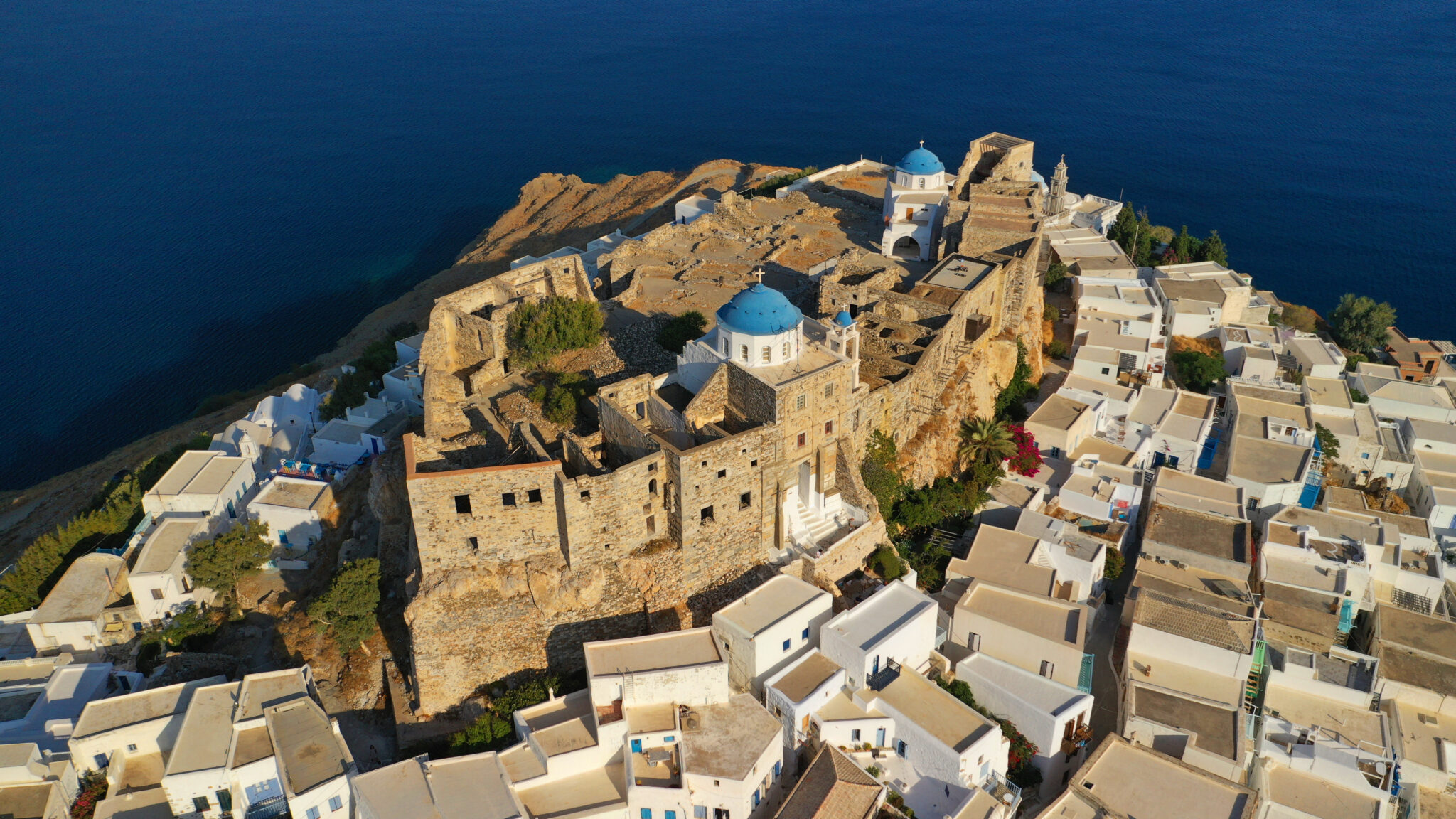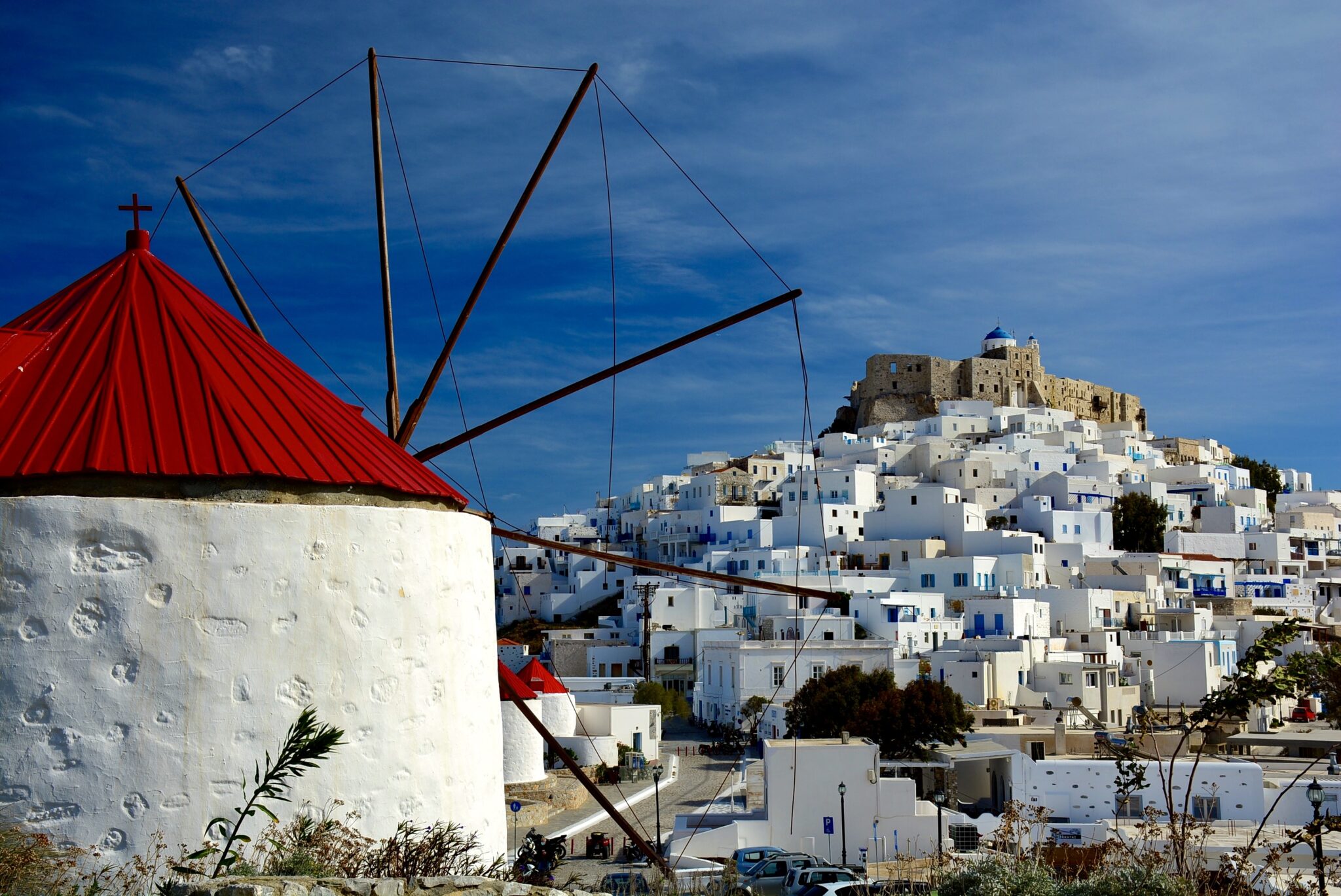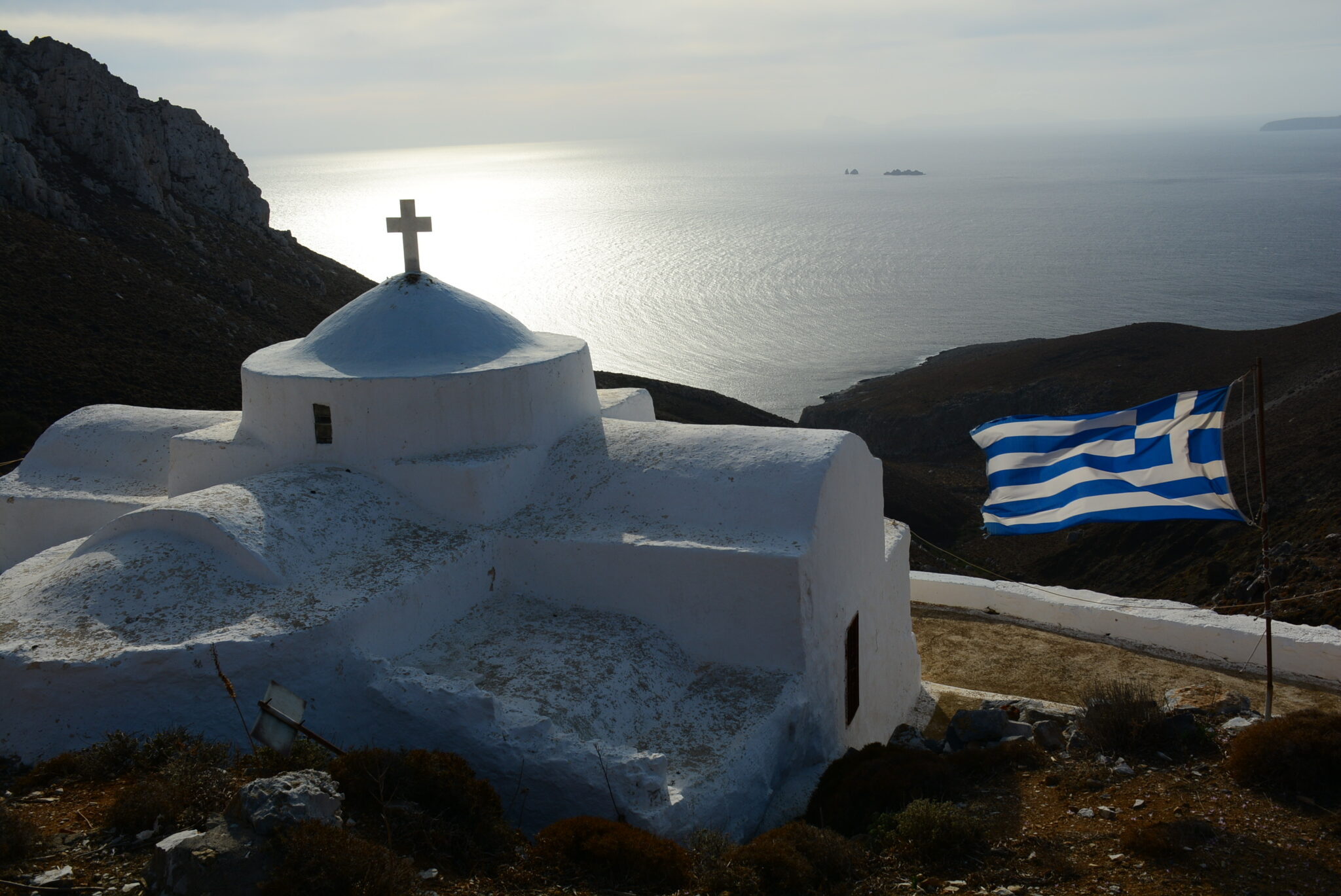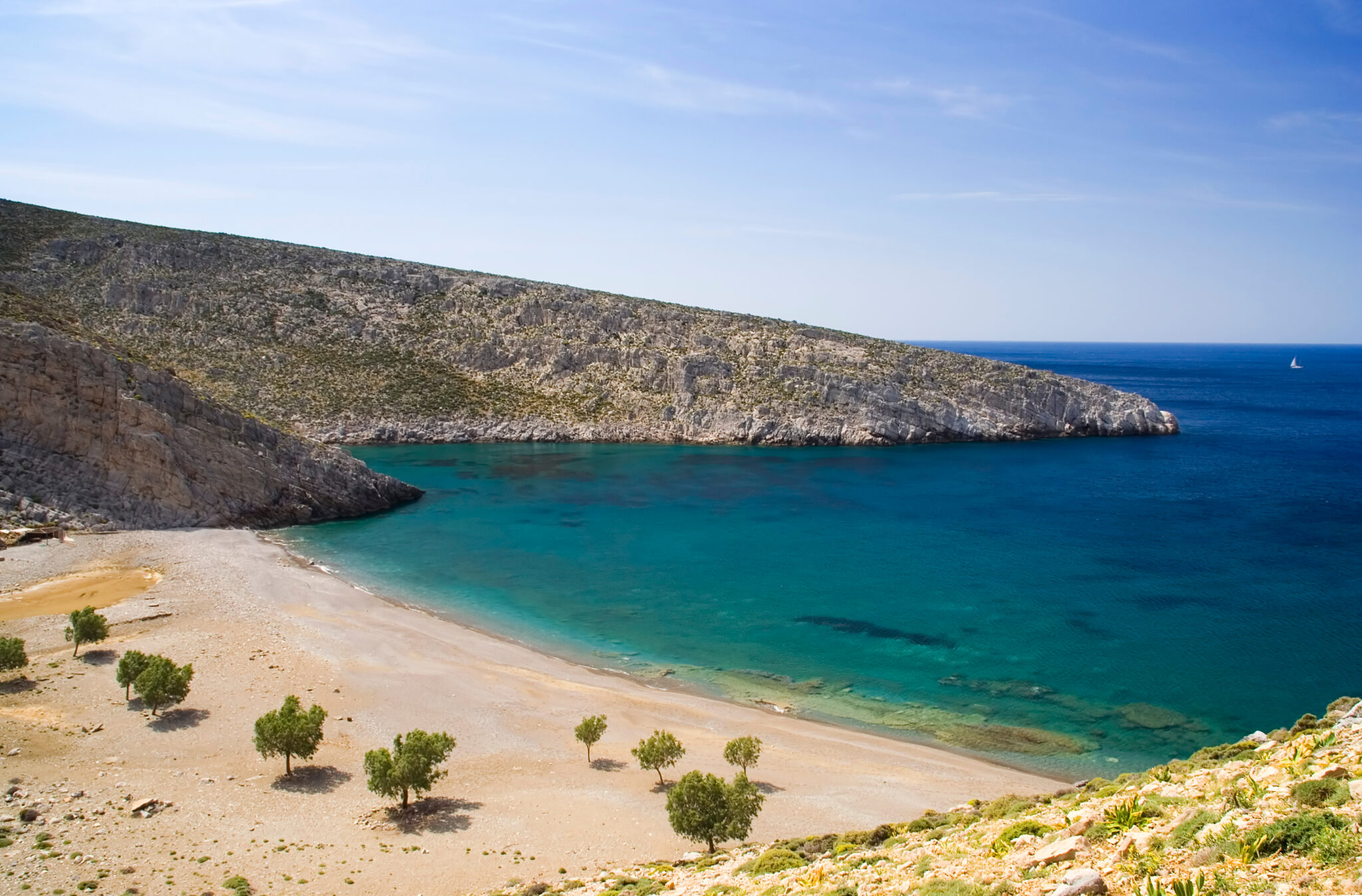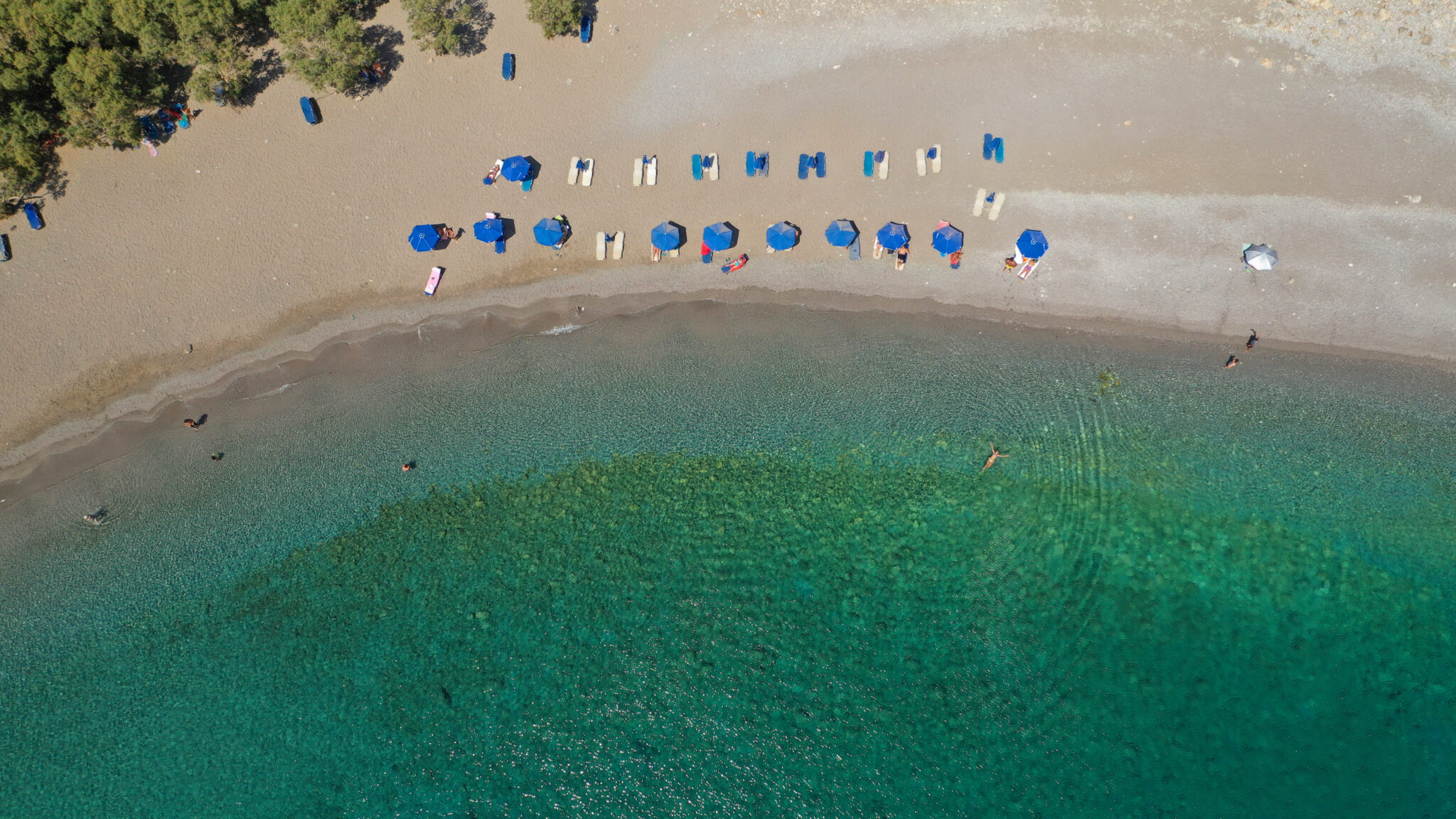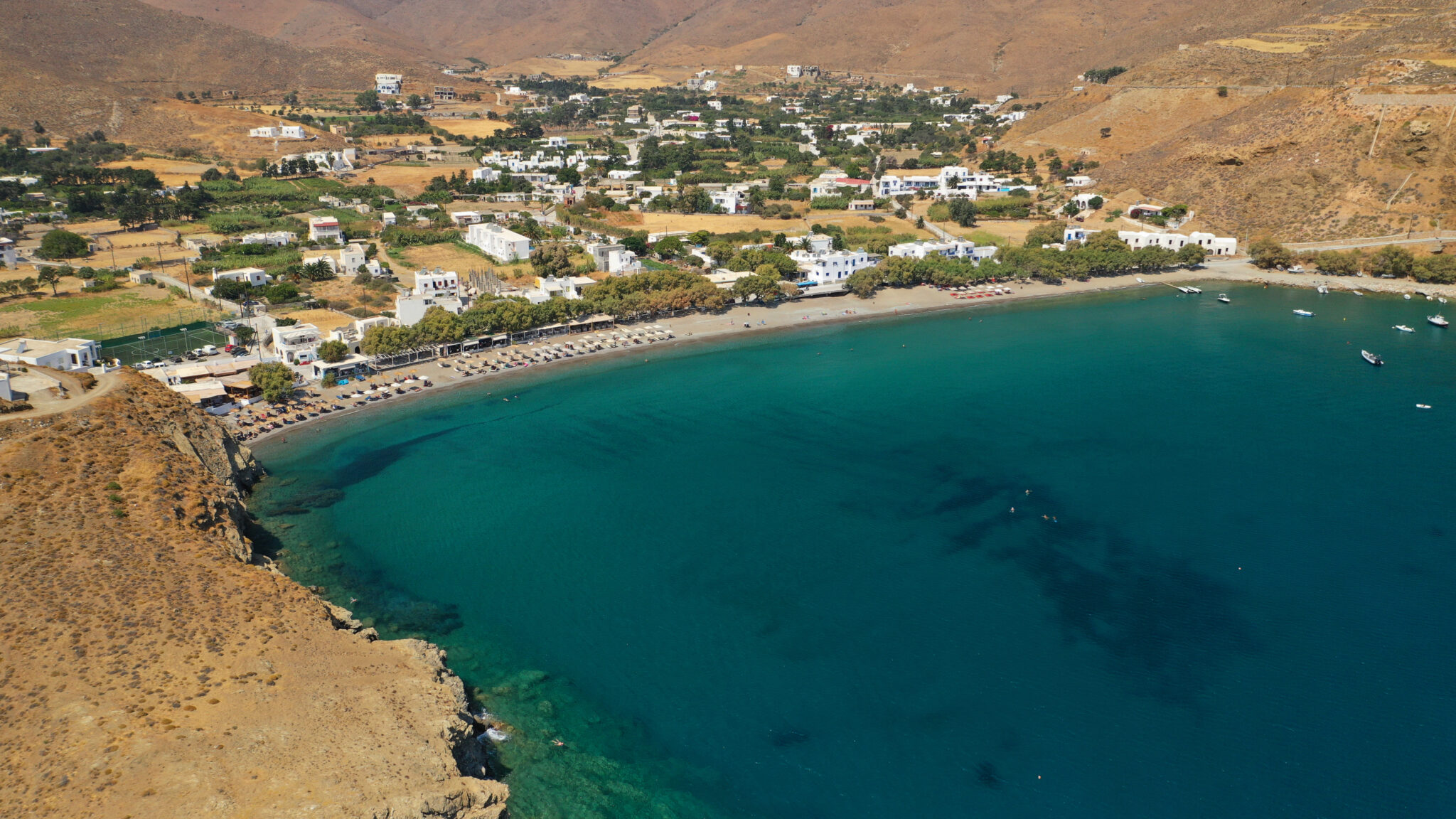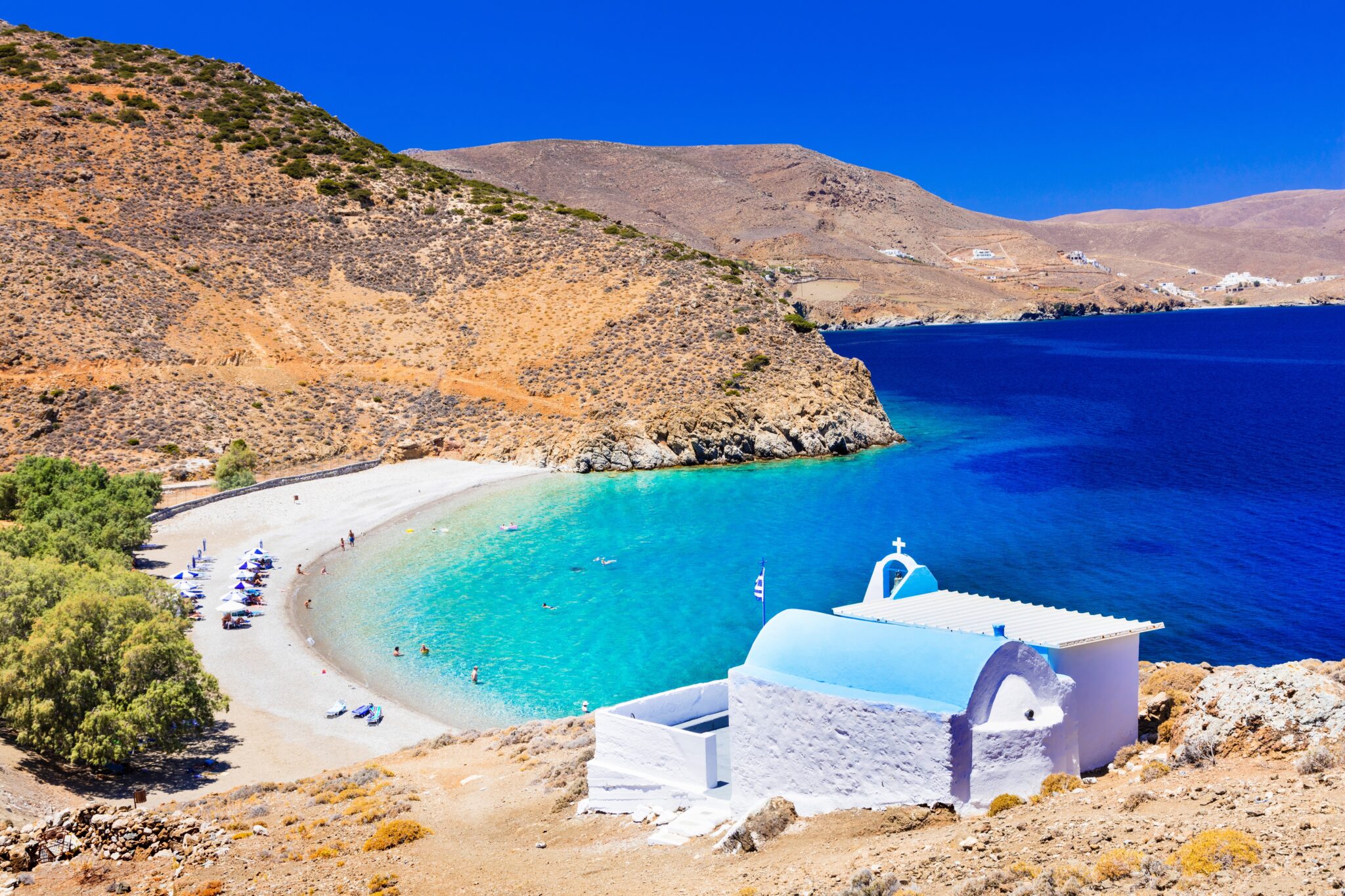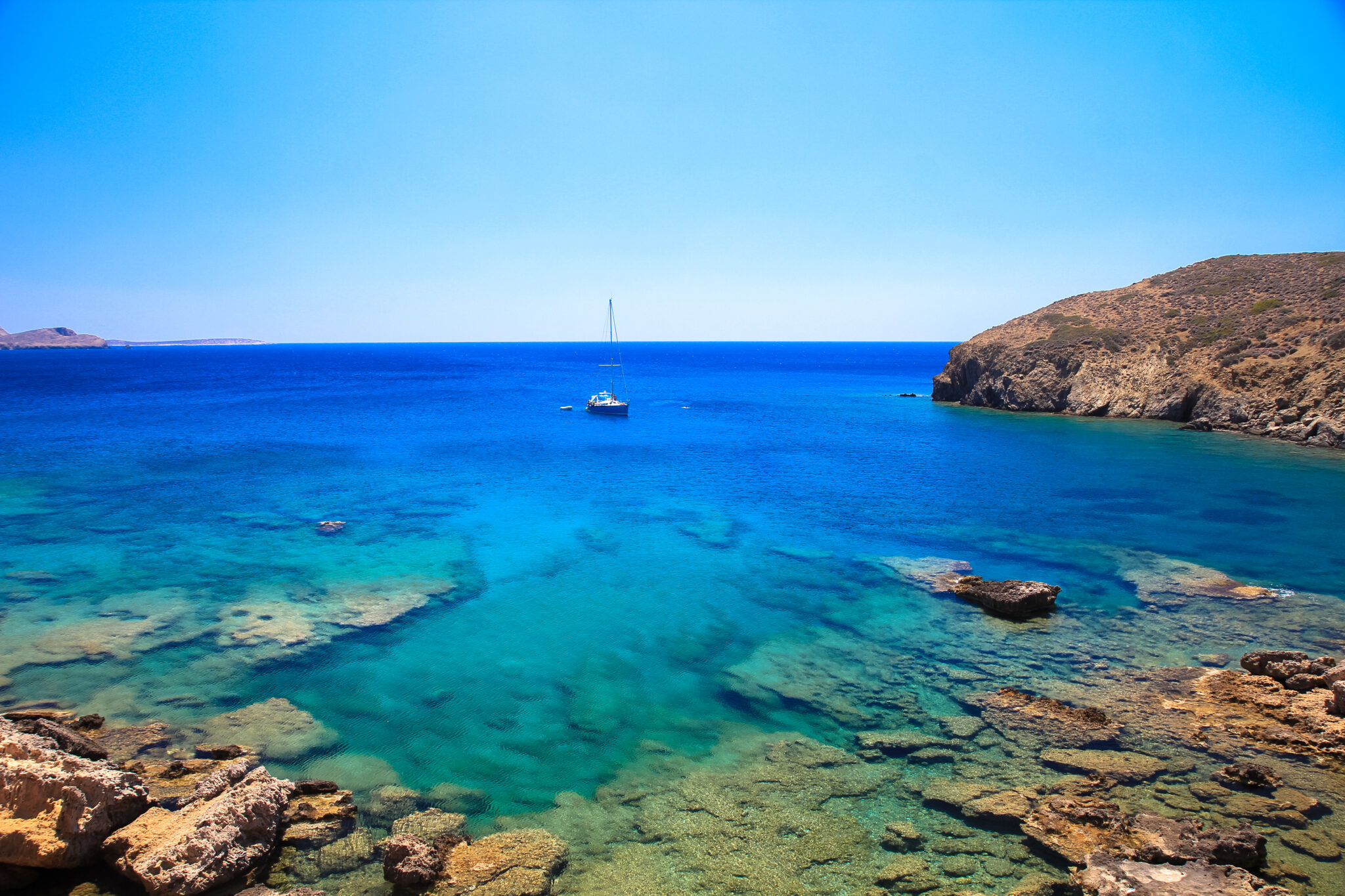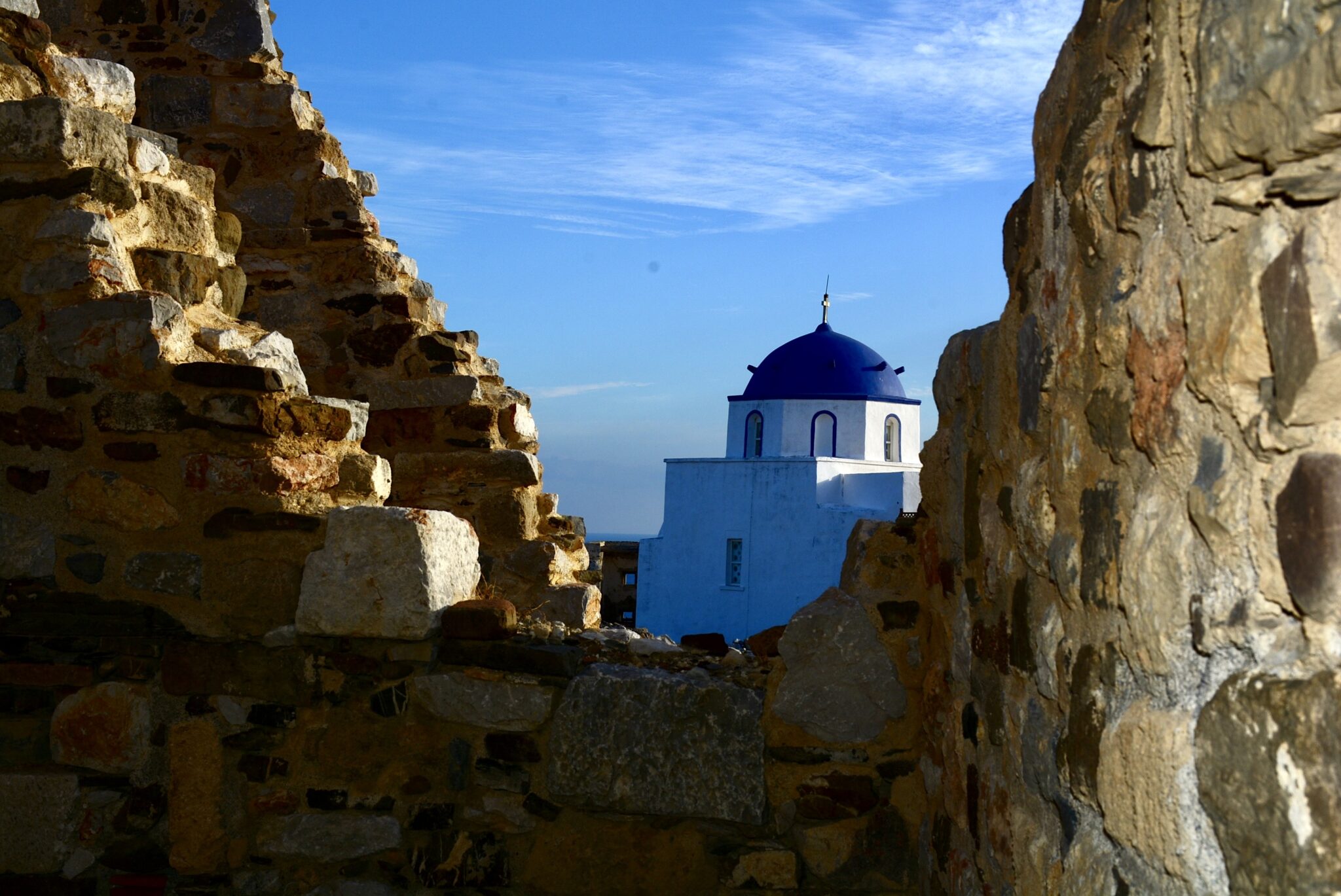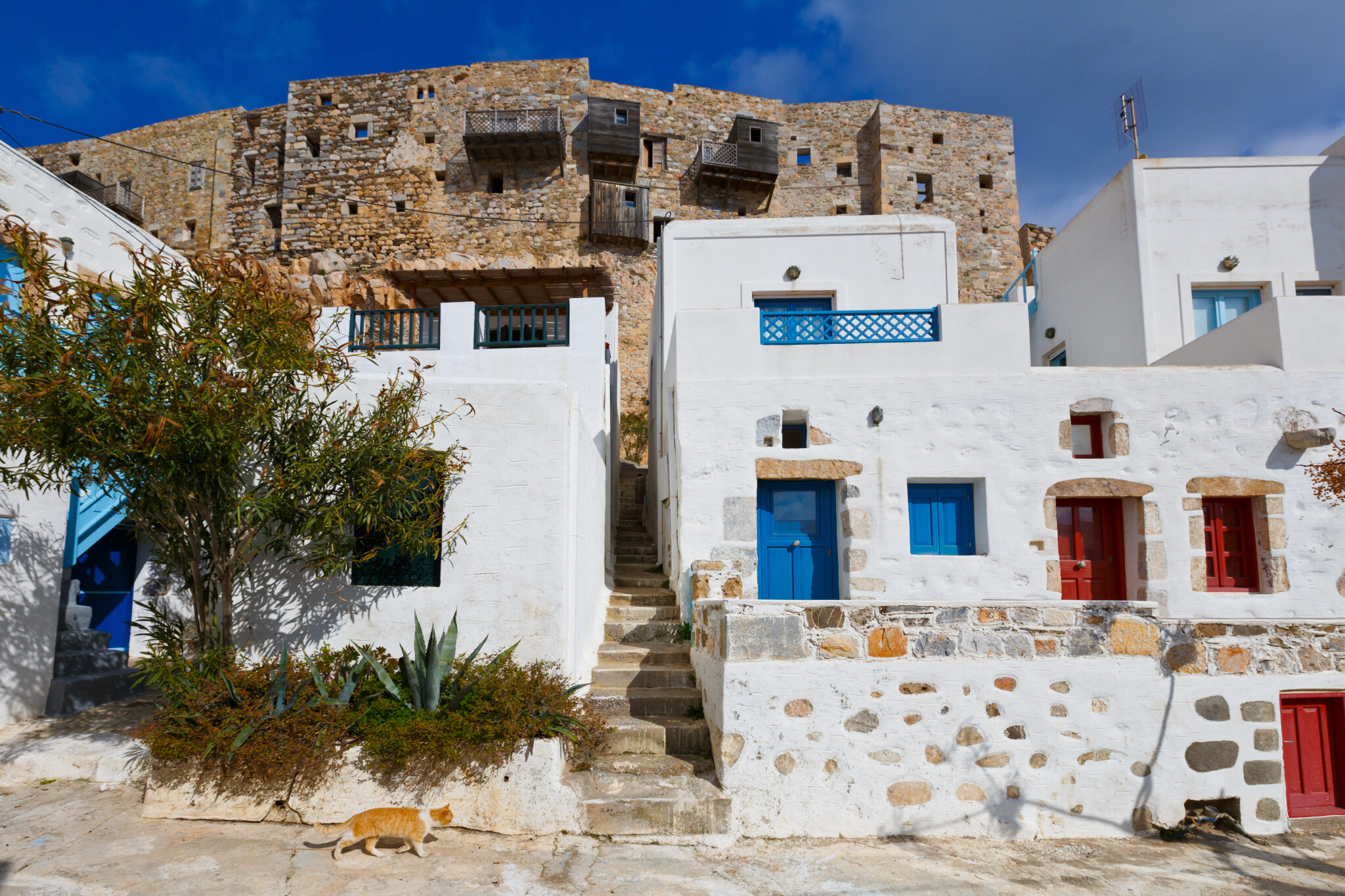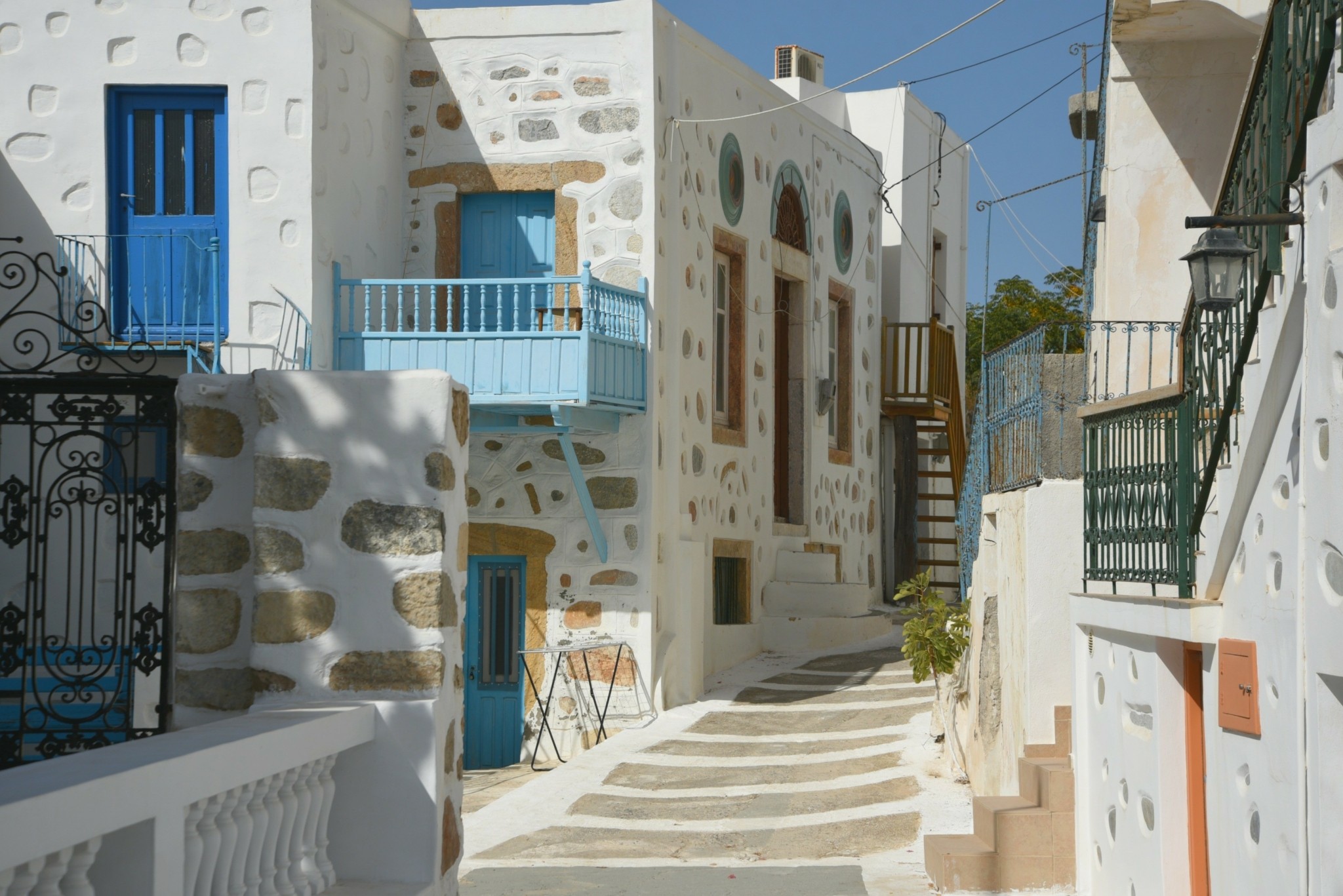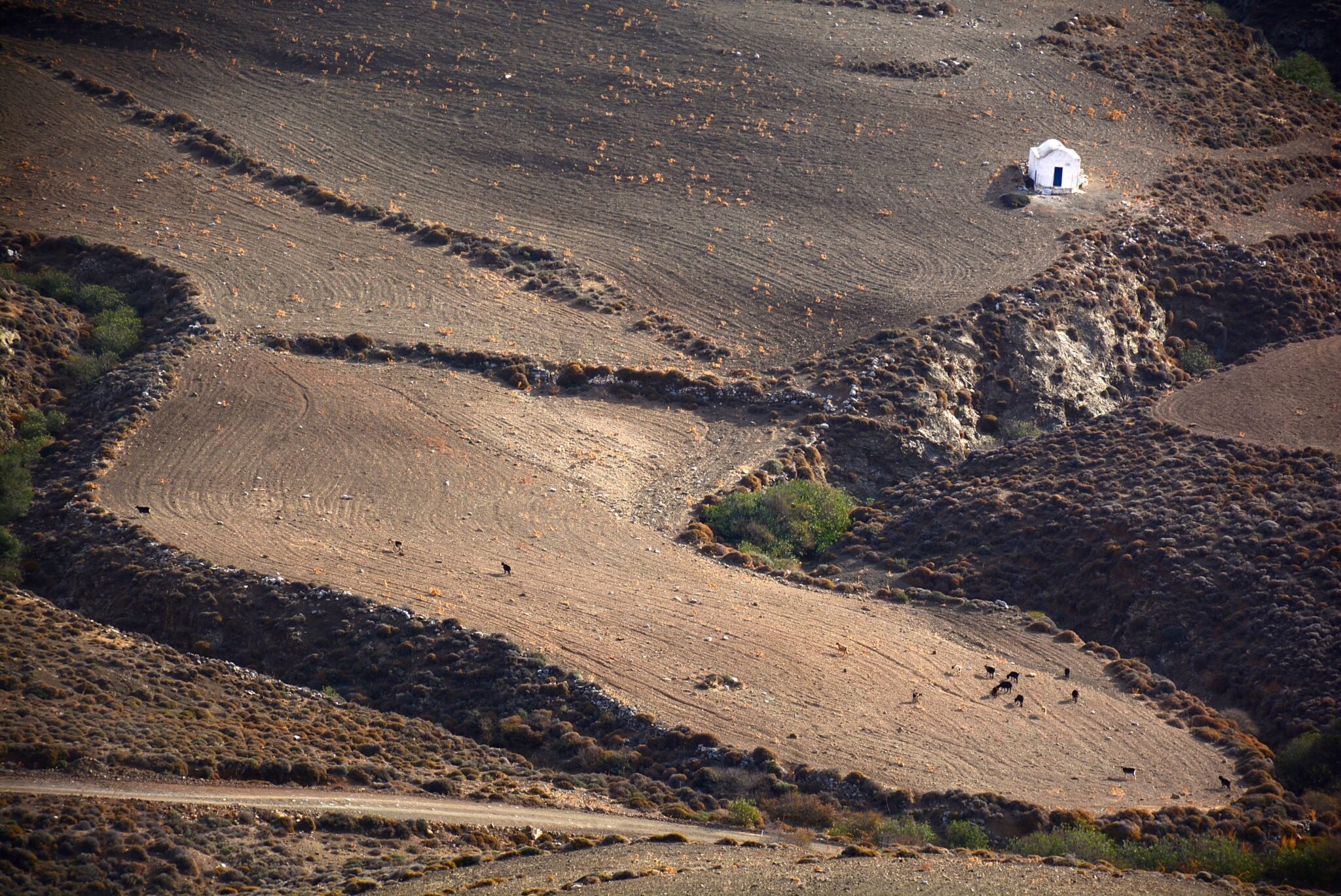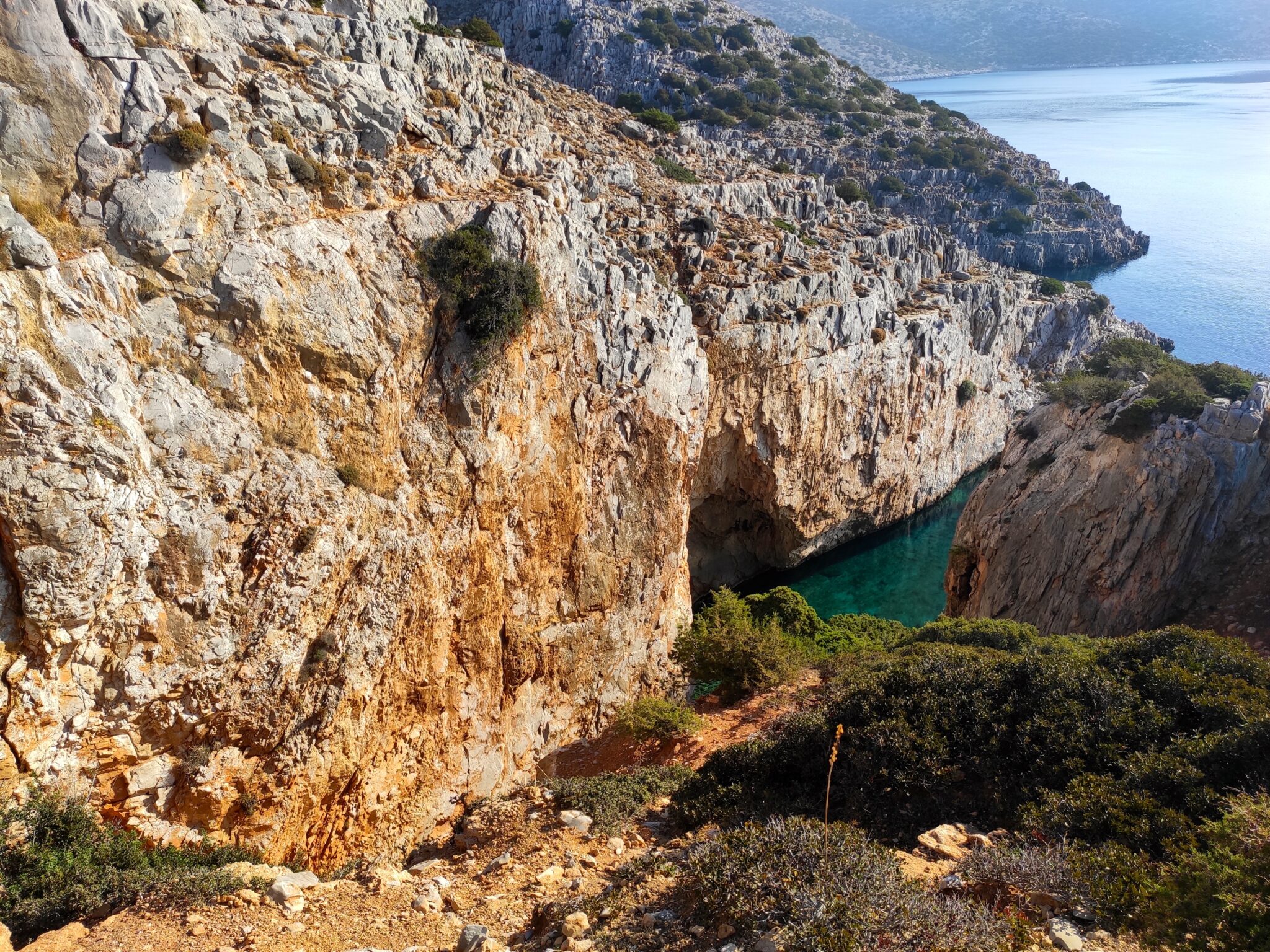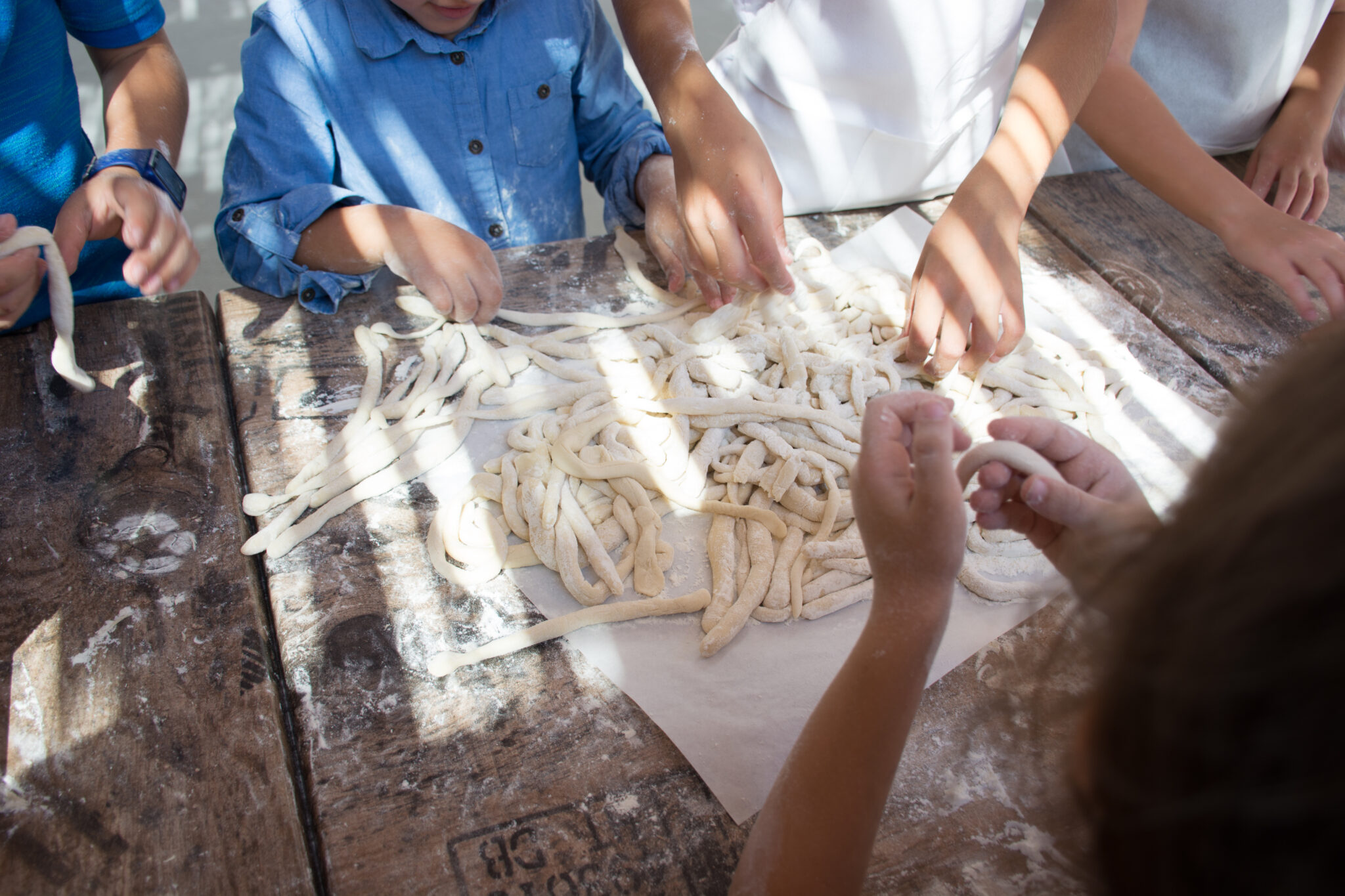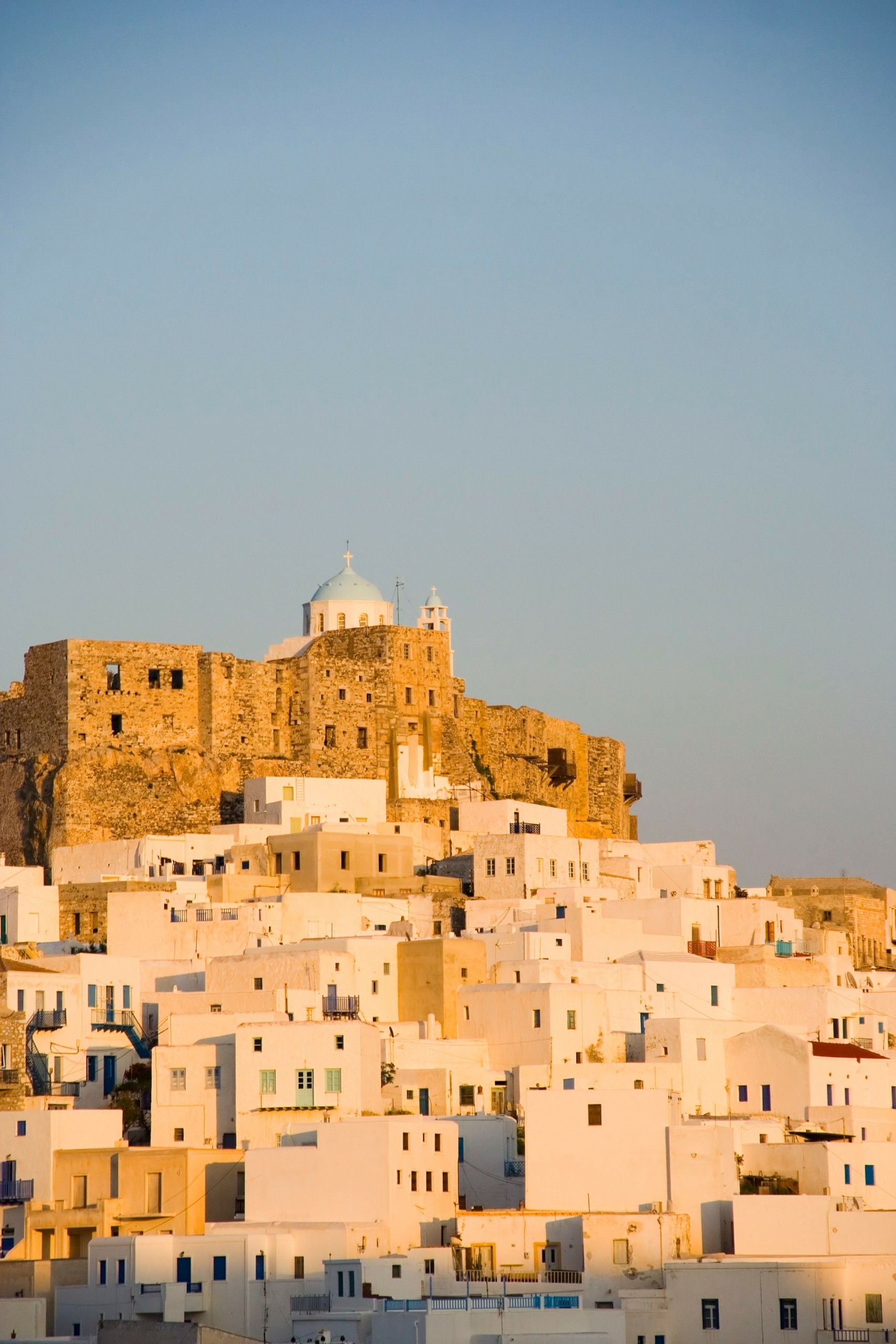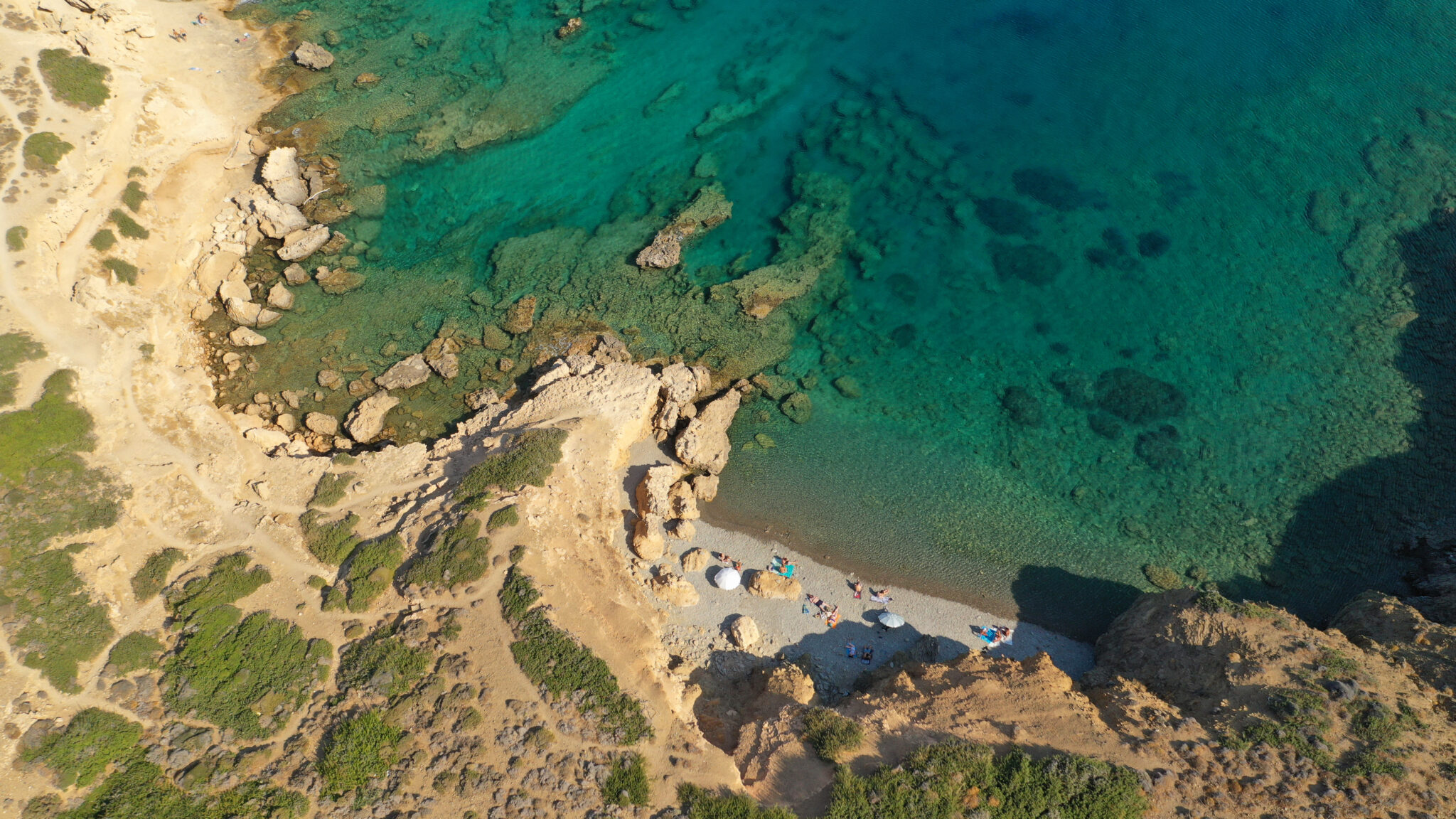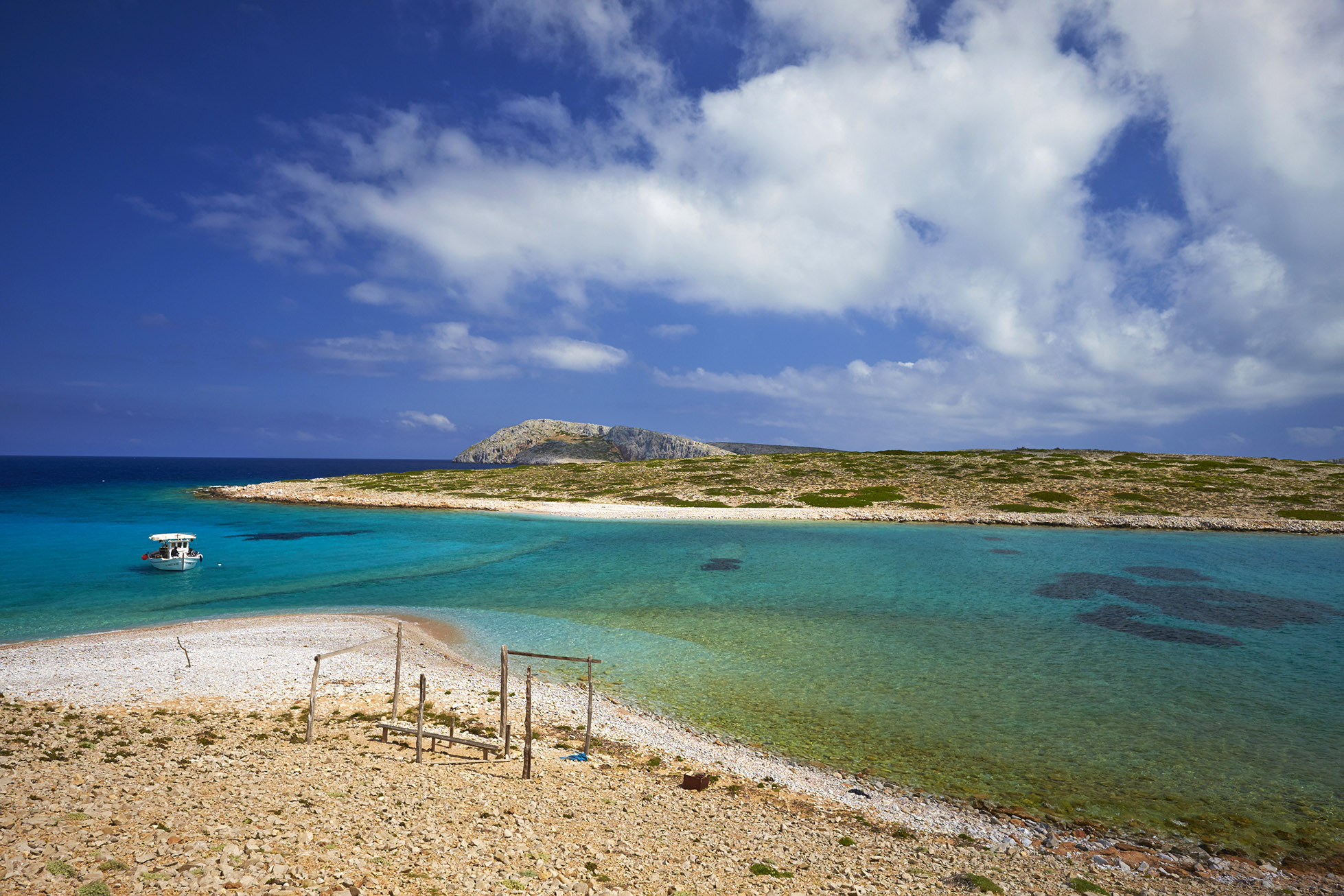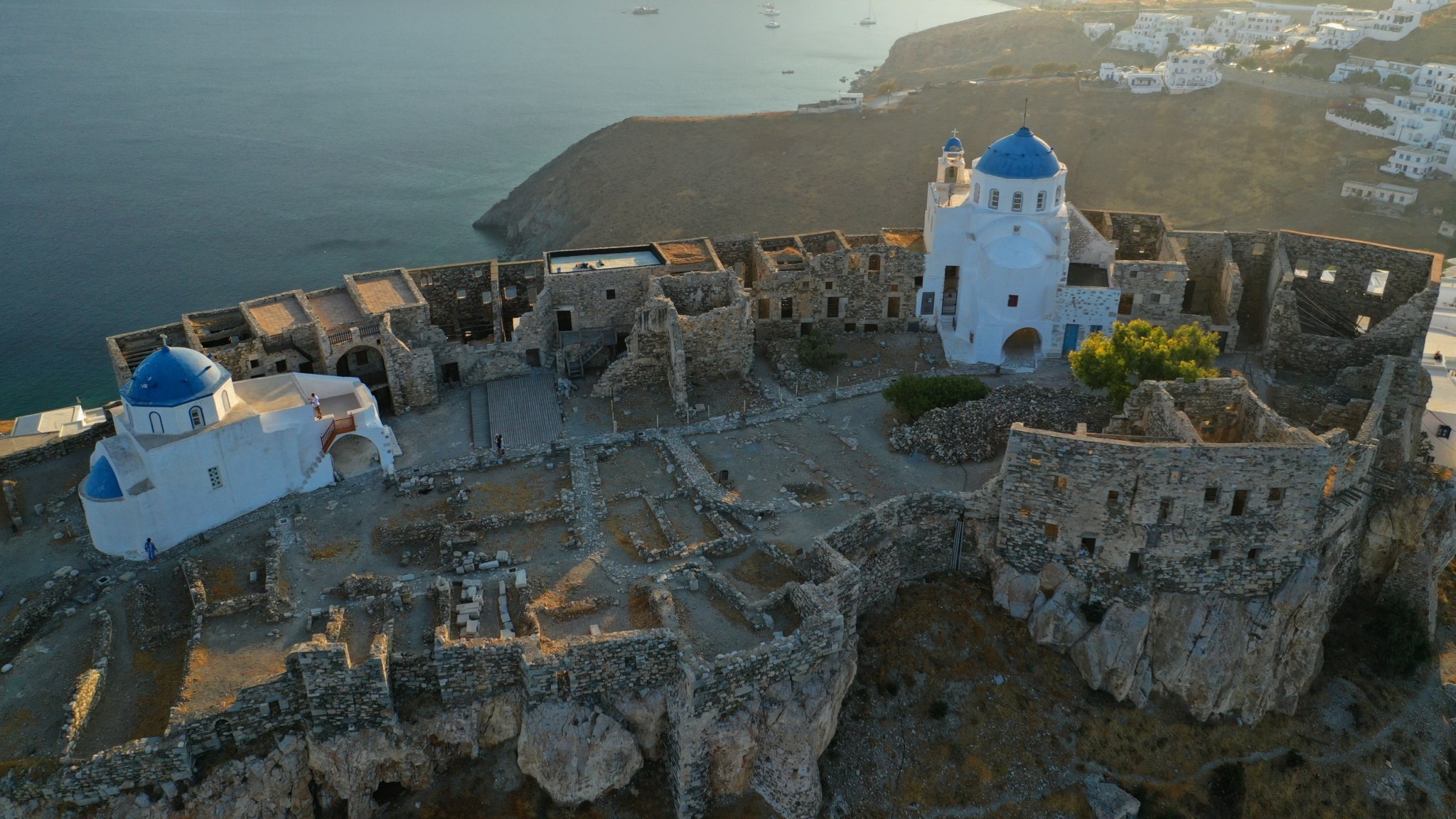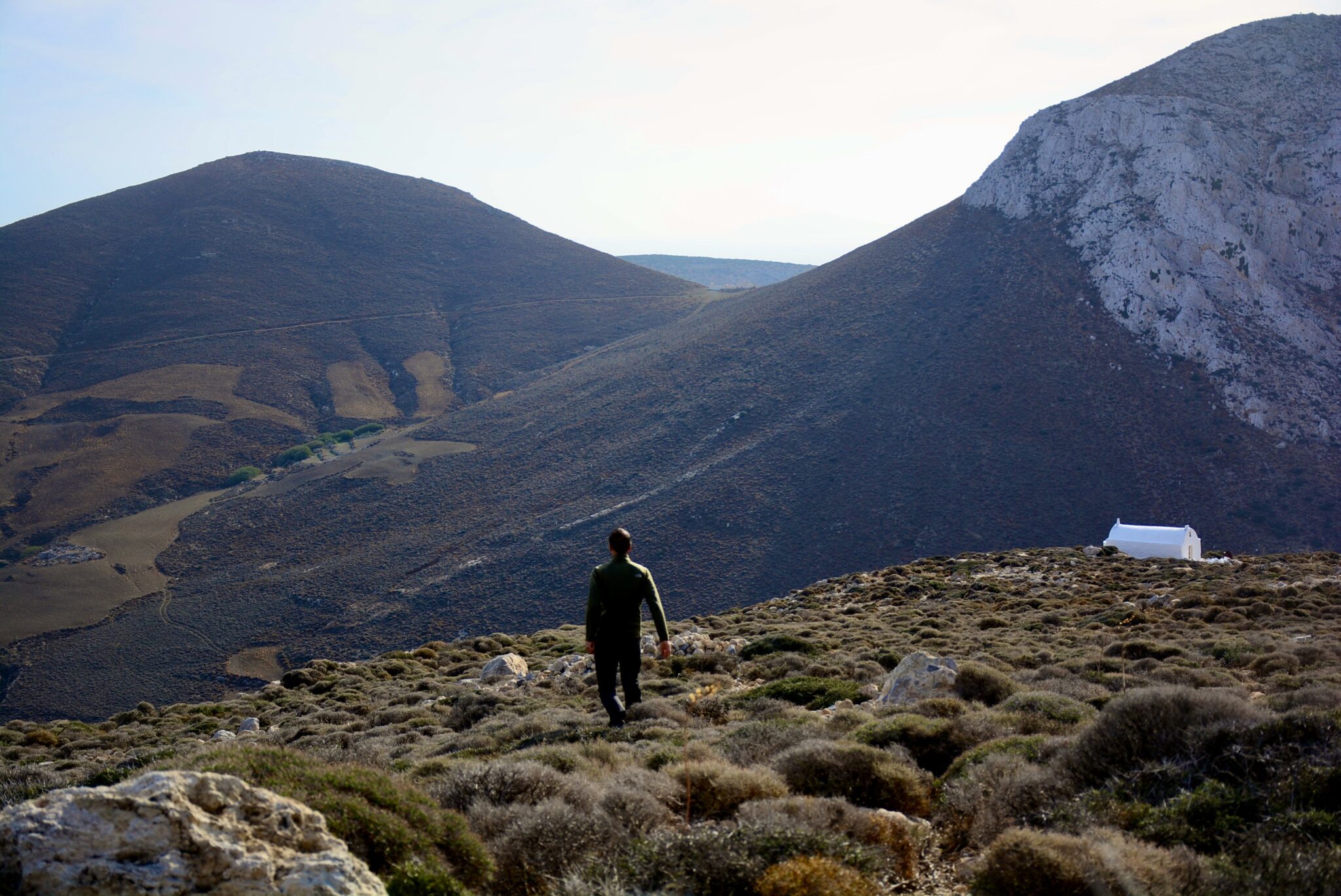Astypalaia, or “Aegean’s Butterfly” as it’s called due to its unique shape, welcomes anyone in search of relaxation and alternative holidays, away from the bustling crowds found every summer on the other islands, with open wings. The distance between Astypalaia and the Greek mainland and its wild beauty prevent most people from visiting. So, only those who crave the unusual thrills it has to offer arrive to its port, prepared to experience the island in full on its scenic alleys and bare landscapes. In recent years, its fame has travelled all over the world, increasing the number of visitors who come here in search of calm, alternative holidays.
Astypalaia’s beaches are mostly rocky and bare, with very few tamarisk trees providing shade to bathers, but there are some serviced beaches suitable even for children, however it’s not a very family friendly destination. Many of the beaches are only accessible by boat, and it’s worth going on a daytrip to swim there.
The island’s terrain is ideal for more adventurous activities: diving off tall rocks, sunbathing on slate slabs, climbing steep rocks, hiking in the rocky landscape, diving and underwater fishing in the beautiful sea.
Hora is bustling with life and every corner is picture perfect, providing material for postcards. The Venetian castle and the churches stand tall, guarding the island’s centre, and the traditional windmills add a touch of folklore charm.
However, if you want to truly get to know the island, you need to try its cuisine and its local products. Meat, cheese, honey, dry farming vegetables, and wild Saffron from the island’s mountains will provide special culinary experiences.
Walk around the villages, on mountainous trails, swim on the windswept beaches and the protected bays, explore the wild caves and the peaceful chapels, stay in wonderful hotels and in tents under the tamarisk trees. Immerse yourself in the alternative and atmospheric life of Astypalaia.
Where to swim
Vatses: Considered one of the most beautiful beaches on the island, it’s ideal for relaxation. It’s mostly pebbled, but in the sea there’s also sand. It’s a serviced beach with a beach bar, a few sunbeds and umbrellas, but there are tamarisks along the beach where you can also set your things. The sea bottom is perfect for snorkelling and underwater fishing. Access is relatively easy, mostly on a dirt road. You can also get to the beach on a boat that leaves from Pera Gialos. In addition, there’s the Cave of Negros, with a long history going back to the Neolithic Era up until the time of the pirates.
Next to Vatses, you’ll find “Mikres Vatses”, a small pebbled beach only accessible by boat – or you can swim the 200m from Vatses. When it’s windy, the waves can become dangerous, so be extra careful.
Kaminakia: It’s one of the best-known beaches on the island, near Vatses, and relatively easily accessible on a dirt road. The beach is mostly sandy, and the sea is deep. There are two taverns on the beach, with some umbrellas and sunbeds, as well as tamarisk trees providing shade.
Livadi: Seafront village with the island’s only fully serviced beach. It has beach bars, taverns, super markets, umbrellas and sunbeds on the beach. The water is crystal-clear and there are also facilities for water sports. It’s just 3km from Hora.
Agios Konstantinos: An easy route, mostly on a paved road, with a small dirt section. The beach is pebbled, and the water is deep. There’s a tavern, a beach bar, umbrellas and sunbeds, as well as tamarisk trees along the beach.
Shinontas: It’s a scenic, calm bay, near the village Maltezana. It’s sandy, with easy access, it has shallow waters and there are restaurants on the beach, as well as sunbeds, umbrellas and a parking lot. It’s an ideal beach for families.
Maltezana: Maltezana’s beach (Analipsi region) is in essence the port’s beach. There are taverns, super markets, and beach bars offering sunbeds and umbrellas, but you can also sit under a tamarisk tree.
Steno: located in the centre of the beach, on the narrow strip that links the two parts of the island, it’s a sandy beach with shallow, clear waters, protected from the winds, so a favourite among families with small children. There is a beach bar offering sunbeds and umbrellas on the beach, as well as tamarisk trees providing shade. Access is easy on the road that connects Hora and Shinontas. And if you don’t have a vehicle, public transport goes there. The secluded beach Mikro Steno is nearby.
Plakes: About 1km from Maltezana, a quiet and secluded beach with fine white pebbles. It’s easily accessible on a small trail that takes about five minutes to walk. One side of the beach is more mild-looking, with fine pebbles, while the other side is wilder, and you can jump off rocks into the water. If you like snorkelling, its seabed is ideal. It’s not a serviced beach. Despite its wild look, it’s protected from the winds and perfect for windy days.
What to do
Querini Venetian Castle: built by the Querini family on the ancient acropolis, it got its final form in the 15th century. Two of the best-known churches on the island are located within the castle, Panagia tou Kastrou (1853) and Agios Georgios (1790). The Panagia Portaitisa church, considered one of the most beautiful churches of the Dodecanese is located nearby.
Hora: Stroll around the traditional Hora with the scenic alleys and the 8 traditional windmills with the red-tiled roofs in the main square. Half of them are in great condition and are used as event and exhibition spaces, a library and a municipal information centre.
Archaeological Museum: Τhe museum’s exhibition includes findings from a long time period, starting in the Prehistoric era and up until the medieval times. You can see prehistoric jewellery, stone tools from tombs of the Mycenaean times, tombstones, clay pots found in necropolises, column chapiters from early Christian basilicas, as well as a marble coat of arms of the Querini family from the Venetian castle.
Hiking: Astypalaia’s terrain is ideal for outdoor activities like hiking and climbing. There are trails all over Astypalaia, opened by the locals in the past to go from one village to the next, or from their homes to their farmlands and the grazelands. The trails go through amazing places and there are maps available. The marking is not thorough, so make sure to have the maps with you, as well as water, a hat, sunglasses, sunblock and light clothes because there’s no shade on the trails nor any water springs.
Apart from hiking, Astypalaia is great for climbing and mountain biking, due to its steep rocks, while there are 20 climbing trails in the Ftera field. (www.terrainmaps.gr)
The island’s culinary identity
Astypalaia is known for its farming and dairy products, including hlorotiri, anthotiro and ladotiri cheese that add to the local cuisine.
The island is covered in wild saffron, thyme, wild sage and mastic trees that make the island’s food aromatic and fragrant.
The local thyme honey is also celebrated for its great quality, and the pasteli (traditional sesame and honey bar) is ever present in local celebrations like weddings and christenings.
The locals also make homemade pasta, like lasagne and makarounes, and make labropita pies (with hlori cheese and saffron), xerotigana (fried dough rolls with honey) and kitrinokouloura (traditional cookies kneaded with saffron giving them a yellow colour), as well as pougia (little dough pouches filled with kopanisti cheese, served with thyme honey).
Other local specialties include goat stuffed with rice and intestines and spices cooked on low fire, the main event of all sorts of festivities, dolmadakia (stuffed vine leaves), stuffed courgette blossoms, meatballs, rantista (lentils with dough), octopus balls and kakavia soup made with the island’s abundant fish and seafood.
Where to eat
Linda: Casserole dishes and traditional local recipes made with homegrown ingredients. The tavern is right next to the water (Kaminakia, Astypalaia, tel.: 0030 693 261 0050)
Kantina sto Steno: traditional casserole dishes made with local ingredients. The tables are next to the water. (Steno, Astypalaia, tel.: 0030 698 069 9394)
Astropelos: They serve fresh fish and seafood, right next to the sea, overlooking the castle. (Livadi, Astypalaia, tel.: 0030 2243 061473)
Antikastro: they serve local dishes with an amazing view of the sea and Hora (Pera Gialos, Astypalaia, tel.: 0030 2243 062316)
Argo: local recipes with their famous pougia being their specialty. They serve raki and rakomelo (raki with honey and spices served hot) and organise nights with live rebetiko music. (Pera Gialos, Astypalaia, tel.: 0030 2243 059854)
Agoni Grami: Homemade makarounes (local pasta) and a great variety of traditional dishes. (Hora, Astypalaia, tel.: 0030 2243 062196)
Where to stay
Pylaia Boutique Hotel & Spa: built on a hill slope overlooking the Aegean Sea, it’s built in a way that resembles a miniature version of the island, with alleys, stone staircases etc. It has 27 rooms and suites, a bar-restaurant and spa. (Hora, tel.: 0030 2243 061001, www.pylaiahotel.gr)
Chrysalis Boutique Hotel Adults Only: They have rooms and suites and offer yoga, massage and facials. They serve homemade breakfast made with local ingredients. (Pera Gialos, tel.: 0030 2243 062221, www.chrysalishotel.eu)
Andromeda Resort: A hotel with a view of the Agios Georgios hill, of Hora and of the Venetian castle. They have 8 rooms that can accommodate up to 3 guests each. (Hora, tel.: 0030 2243 059865, https://andromedaresort.gr/diamoni)
Arhitektoniki: Each house here is different, with a separate entrance and a private yard. The houses are built on different levels and have an unobstructed view of Hora. (Livadi, tel.: 0030 2243 059830, www.arhitektoniki.gr/el)
Astypalaia Camping: The camping site is located in B’ Marmari and is surrounded by reeds and trees. The beach is located just a few steps from the camping’s entrance and there’s a bar within the camping where live performance often take place.
There’s a restaurant, a café, a bar and a mini market, shared fridges, shared cooking spaces, shared washing machines, hot water and free transportation from the port at ship times. (B Marmari, tel.: 0030 2243 061900, www.astypalaiacamping.gr)
Read also:
Astypalaia: the top 10 hiking trails on “Aegean’s Butterfly”



